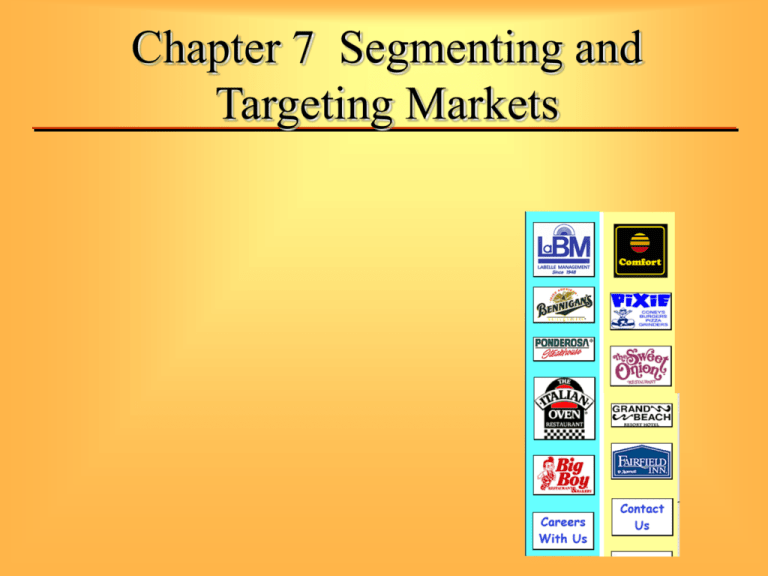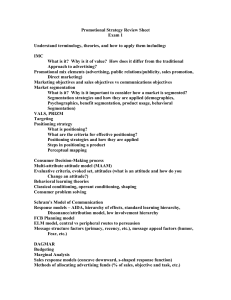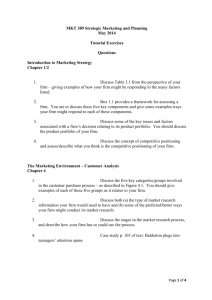presentation source
advertisement

Chapter 7 Segmenting and Targeting Markets The Importance of Market Segmentation Markets have a variety of product needs and preferences Marketers can better define customer needs Decision makers can define objectives and allocate resources more accurately Criteria for Segmentation Substantiality Segment must be large enough to warrant a special marketing mix. Identifiability Measurability Segments must be identifiable and their size measurable. Members of targeted segments must be reachable with Accessibility marketing mix. Unless segment responds to a Responsiveness marketing mix differently, no separate treatment is needed. Bases for Segmentation Geography Bases Used to Segment Consumer Markets Demographics Psychographics Benefits Sought Usage Rate Geographic Segmentation • Region of the country or world • Market size • Market density • Climate Bases for Demographic Segmentation • Age • Gender • Income • Ethnic background • Family Life Cycle Ethnic Background • Largest ethnic markets are: African-American Hispanic-American Asian-American • Will comprise 1/3 of U.S. population by 2010 with buying power of a trillion dollars Family Life Cycle Age Marital Status Children Bases for Psychographic Segmentation Personality Motives Lifestyles Psychographic Segmentation Geodemographics Lifestyle Segmentation • How time is spent • Beliefs • Socioeconomic characteristics Geodemographic Segmentation Segmenting potential customers into neighborhood lifestyle categories. Combines geographic, demographic, and lifestyle segmentation. Quartiles of County Residents of Asian Descent CLARTAS’ PRIZM 62 American clusters Each cluster is a member of 15 social groups arranged by urbanization density and socio-economic standing. County City High $ $ Low RURAL TOWN 2nd CITY SUBURB URBAN CLARTAS’ PRIZM 62 American clusters Each cluster is a member of 15 social groups arranged by urbanization density and socio-economic standing. 01: BLUE BLOOD ESTATES05: KIDS & CUL-DE-SACS 07: MONEY & BRAINS 09: AMERICAN DREAMS 12: UPWARD BOUND 14: COUNTRY SQUIRES 18: YOUNG INFLUENCIALS 28: BIG CITY BLEND 31: LATINO AMERICA 40: MILITARY QUARTERS 41: SHOTGUNS & PICKUPS 62: HARD SCRABBLE To look up a ZIP code use http://www.velocity.claritas.com/YAWYL/Default.wjsp?System=WL For definitions of each cluster, see http://www.qmsoft.com/solutions/prizm.htm for complete descriptions VALS 2 Dimensions Abundant Resources Principleoriented Statusoriented Actionoriented Actualizers Minimal Resources Fulfillers Achievers Experiencers Believers Strivers Makers Strugglers Benefit Segmentation The process of grouping customers into market segments according to the benefits they seek from the product . Usage-Rate Segmentation Dividing a market by the amount of product bought or consumed. The 80/20 Principle A principle holding that 20 percent of all customers generate 80 percent of the demand. Steps in Segmenting a Market Select a market for study Choose bases for segmentation Select descriptors Profile and analyze segments Select target markets Design, implement, maintain mkting mix Strategies for Selecting Target Markets Undifferentiated Concentrated Strategy Strategy Multisegment Strategy Undifferentiated Targeting Strategy Advantages: Potential savings on production and marketing costs Disadvantages: Unimaginative product offerings Company more susceptible to competition Concentrated Targeting Strategy Advantages: Concentration of resources Meets narrowly defined segment Small firms can compete Strong positioning Disadvantages: Segments too small, or changing Large competitors may market to niche segment Multisegment Targeting Strategy Advantages: Greater financial success Economies of scale Disadvantages: High costs Cannibalization Costs of Multisegment Targeting $ $ $ $ $ $ $ Product design costs Production costs Promotion costs Inventory costs Marketing research costs Management costs Cannibalization Cannibalization Situation that occurs when sales of a new product cut into sales of a firm’s existing products. Positioning Developing a specific marketing mix to influence potential customers’ overall perception of a brand, product line, or organization in general. Effective Positioning • Assess the positions of competing products • Determine the dimensions of these positions • Choose an effective market position Perceptual Mapping--Levi’s High Price Vintage Red Line Slates Classic Red Tab Dry Goods 501 Dockers Classics Red Tab Basics L2 Designer Dockers Premium Red Tab Elesco Silver Tab Old product Low Price New product Positioning Bases Attribute Price and Quality Use or Application Product User Positioning Bases Product Class Competitor Repositioning Changing consumers’ perceptions of a brand in relation to competing brands. Guess Who Owns Theses Brands? What are the segments that each is directed toward? See http://www.gloss.com/interim_flash.html High Product Positioning Low Low Richness High Why Do Consumers Purchase Technology? Primary Motivation High Career Entertainment Status Fast Forwards Mouse Potatoes Cyber-snobs Technostrivers Gadget Grabbers X-techs Handshakers Media Junkies Country Clubbers High Low Neohearthminders Low Disposable Income Disposable Income Technology pessimists Technology optimists Family Traditionalists Sidelined Citizens Source: Forrester Research, Inc.








